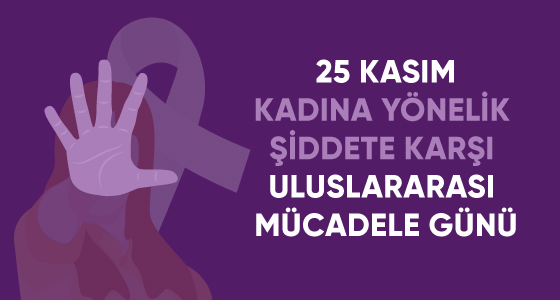News

November 25: International Day for the Elimination of Violence Against Women
The designation of this day is based on a tragic and real story. On November 25, 1960, forces loyal to Dominican Republic dictator Rafael Trujillo brutally murdered three sisters—Patria, Minerva, and Maria Mirabal—who opposed his oppressive rule. One year after their murder, the anti-Trujillo movement succeeded in ending the dictatorship. Many years later, in 1981, the Latin American Women’s Congress held in the Dominican Republic declared November 25 as the International Day for the Elimination of Violence Against Women to commemorate this tragedy and promote global solidarity.
The International Day for the Elimination of Violence Against Women was officially declared by the United Nations General Assembly in 1999 to raise awareness about gender-based violence. The UN Committee on the Elimination of Discrimination Against Women defines violence against women as "violence directed at women because they are women or violence that disproportionately affects women." The committee emphasizes that gender-based violence is a form of discrimination that severely hinders women's ability to exercise their rights and freedoms on an equal basis with men. Violence against women, whether occurring in public or private spaces, causes physical, psychological, social, sexual, and economic harm, as well as damage to their dignity. It is also a fundamental human rights violation, as it infringes upon the right to life, the prohibition of torture and ill-treatment, the right to liberty and security, and the right to physical and emotional integrity.
A Global Issue with Devastating Impacts
Violence against women is a global issue with destructive effects on societies. According to the World’s Women: Trends and Statistics 2020 report by the United Nations Department of Economic and Social Affairs, an estimated 18% of women and girls aged 15-49 experienced physical and/or sexual intimate partner violence in the past 12 months. To raise awareness, the UN designated the 2021 campaign theme as "Orange the World: End Violence Against Women Now!"
Statistics indicate that one in three women worldwide experiences violence. In Turkey, the Domestic Violence Against Women Survey, conducted by the General Directorate on the Status of Women (KSGM) in 2008 and 2014, revealed that approximately four out of ten women have experienced physical and/or sexual violence from their partners at some point in their lives. Research highlights that violence against women takes many forms, including physical, emotional, sexual, economic, digital, dating violence, stalking, and social violence.
Contributing Factors and Societal Impact
Alcohol and substance abuse are frequently associated with violence against women. While some studies (Vahip & Doğanavşargil, 2006; Balci & Ayranci, 2005; Ortabag et al., 2014) do not find a direct correlation, research suggests that men who consume alcohol daily are more likely to perpetrate physical and sexual violence (Yüksel-Kaptanoğlu & Çavlin, 2015). Studies also indicate that childhood abuse is a key factor in predicting both perpetrators and victims of violence in adulthood (Güleç et al., 2006; Ortabağ et al., 2014). Additionally, social attitudes toward violence play a crucial role—social support can act as a protective factor, but in some cases, families and social circles discourage women from seeking help (Fabiano et al., 2003; Yıldırım, 1998; Boyacıoğlu, 2016). In patriarchal societies, the belief in male superiority and unequal power dynamics within the family are considered fundamental causes of gender-based violence (Mor Çatı, 1996).
The Need for a Multifaceted Approach
These findings emphasize the necessity of a comprehensive and coordinated approach to combat violence against women effectively. In addition to prevention mechanisms, social policies must be developed to address the root causes of gender inequality. Since education begins within the family, efforts should focus on reshaping power dynamics at home, eliminating discriminatory and degrading attitudes in media and education, and promoting gender-sensitive policies to reduce and ultimately eradicate violence.
When individuals face violence or feel unsafe, they can use the KADES mobile application, which allows women experiencing or at risk of domestic violence to quickly report incidents and access emergency support services. Additionally, municipalities, local governments, NGOs, and educational institutions organize training programs on domestic violence prevention, anger management, and emotional expression skills. Recognizing that combating violence is possible regardless of gender and that a brighter future is achievable globally should be a collective goal.
Clinical Psychologist Gözde Ceylan Pehlivan
Psychological Counseling Center
References
- Balci, Y. G. & Ayranci, U. (2005). Physical violence against women: Evaluation of women assaulted by spouses. Journal of Clinical Forensic Medicine, 12, 258-263.
- Boyacıoğlu, İ. (2006). Dünden Bugüne Türkiye'de Kadına Yönelik Şiddet ve Ulusal Kadın Çalışmaları: Psikolojik Araştırmalara Davet. Türk Psikoloji Yazıları, 19 (126-145).
- Fabiano, P. M., Perkins, H. W., Berkowitz, A., Linkenbach, J., & Stark, C. (2003). Engaging men as social justice allies in ending violence against women: Evidence for a social norms approach. Journal of American College Health, 52(3), 105-112.
- Güleç, H., Topaloğlu, M., Ünsal, D., & Altıntaş, M. (2012). A vicious cycle: Violence. Psikiyatride Güncel Yaklaşımlar, 4(1), 112-137.
- Mor Çatı Kadın Sığınağı Vakfı (2008). Women’s Solidarity Against Male Violence. Istanbul: Mor Çatı Publications.
- Ortabag, T., Ozdemir, S., Bebis, H., & Ceylan, S. (2014). Perspectives of young adult men regarding violence against women: A cross-sectional study from Turkey. Journal of Family Violence, 29, 665-674.
- Yüksel-Kaptanoğlu, İ. & Çavlin, A. (2015). Prevalence of violence against women. In Domestic Violence Against Women in Turkey (81-122). Hacettepe University Institute of Population Studies, Ankara: Elma Technical Printing.
- Vahip, I. & Doğanavşargil, Ö. (2006). Domestic physical violence and female patients. Turkish Journal of Psychiatry, 17(2), 107-114.
- https://psikiyatri.org.tr/basin/553/turkiye-psikiyatri-dernegi-25-kasim-kadina-yonelik-siddete-karsi-uluslararasi-m
- https://www.yesilay.org.tr/tr/makaleler/kadina-yonelik-siddete-karsi-25-kasim-kadina-yonelik-siddete-karsi-uluslararasi-mucadele-gunu
- https://www.yesilay.org.tr
